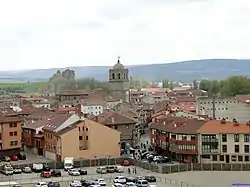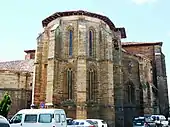Aguilar de Campoo
Aguilar de Campoo (Spanish pronunciation: [aɣiˈlaɾ ðe kamˈpo]) is a town and municipality of Spain located in the province of Palencia, autonomous community of Castile and León. It is close to the River Pisuerga. Its 2011 population is 7741.[2]
Aguilar de Campoo | |
|---|---|
 | |
 Coat of arms | |
 Aguilar de Campoo Location in Spain  Aguilar de Campoo Aguilar de Campoo (Spain) | |
| Coordinates: 42°48′N 4°16′W | |
| Country | Spain |
| Autonomous community | Castile and León |
| Province | Palencia |
| Government | |
| • Mayor | María José Ortega Gómez |
| Area | |
| • Total | 30.62 km2 (11.82 sq mi) |
| Elevation | 892 m (2,927 ft) |
| Population (2018)[1] | |
| • Total | 6,842 |
| • Density | 220/km2 (580/sq mi) |
| Demonym | Aguilarenses |
| Time zone | UTC+1 (CET) |
| • Summer (DST) | UTC+2 (CEST) |
| Postal code | 34800 |
It is one of the locations of the St. James' Northern Way (Ruta del Besaya). Since 2017, the municipality has been included in the Geopark of Las Loras,[3] the first UNESCO Geopark in Castile and León.
History

In May 1255 Alfonso X the Wise granted Aguilar a royal fuero,[4] and thus the town also became a realengo ('royal demesne').[5] The town maintained that status until 1332. The town featured a seizeable Jewish community in the middle ages.[6]
Gullón and Fontaneda opened biscuit factories in 1904 and 1913, respectively, and the town acquired a reputation as a renowned biscuit-making centre in Spain in the 20th century.[7]
Main sights
Religious architecture
- Monastery of Santa María la Real (11th-13th centuries)
- Collegiate Church of San Miguel (11th-16th centuries)
- Church of Olleros de Pisuerga (7th-9th centuries)
- Hermitage of Santa Cecilia (12th century)
- Church of San Andrés (12th century)
- Monastery of Santa Clara (founded in 1430)
Civil architecture


- Medieval castle
- Major Square
- Palace of the Manrique (Marquess of Aguilar de Campoo)
- Palace of the Villalobos-Solorzano
- Palace of the Marquises of Villatorre
- House of the Priest
- House of Santa Mª La Real
- House of the Marcos Gutierrez
- House of the Seven Linajes (lineages)
- House of the Velardes
- Medieval walls and gates
Bridges
- Major Bridge
- Bridge of Portazgo
- Bridge of Turruntero Mill
- Bridge of la Teja
- Bridges of Paseo de la Cascajera
- Bridges of Tenerias
Industry
In Aguilar is Galletas Gullón factory, the largest manufacturer of biscuits in Spain and one of the largest in Europe.
References
- Citations
- Municipal Register of Spain 2018. National Statistics Institute.
- "AGUILAR DE CAMPOO - Palencia". Archived from the original on 2013-01-21. Retrieved 2013-02-02.
- Las Loras UNESCO global geopark (Spain)
- Huidobro y Serna 1954, p. 79.
- Lorenzo, Lía Z. (28 March 2021). "Aguilar de Campoo, un vergel natural y un paraíso arquitectónico". El norte de Castilla.
- Huidobro y Serna 1954, pp. 86–87.
- Moreno Lázaro 2001, pp. 207, 215.
- Bibliography
- Huidobro y Serna, Luciano (1954). "Breve Historia y descripción de la Muy Leal Villa de Aguilar de Campoo" (PDF). Publicaciones de la Institución Tello Téllez de Meneses (12): 5–230. ISSN 0210-7317.
- Moreno Lázaro, Javier (2001). "La dulce transformación. La industria galletera española en la segunda mitad del siglo XX". Revista de Historia Industrial (19): 205–247.
External links
- Official website (in Spanish)
- Información, historia, fiestas y fotografias de Aguilar de Campoo (in Spanish)